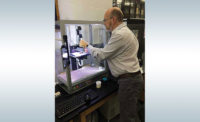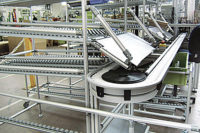Robotic grippers and 3D printing are two passions of Hod Lipson, an associate professor of mechanical and aerospace engineering and computer science at Cornell University. The facility was created by Lipson in 2001 to develop robots that “create and are creative. We explore novel autonomous systems that can design and make other machines automatically,” he points out.. “Our work is inspired from biology, as we seek new biological concepts for engineering and new engineering insights into biology.”
Lipson and his colleagues recently created a versatile gripper using everyday ground coffee and a latex party balloon. They call the device a universal gripper, because it conforms to the object it’s grabbing, rather than being designed for particular objects.
A balloon filled with ground coffee is attached to a robotic arm. It presses down and deforms around the desired object, and then a vacuum sucks the air out of the balloon, solidifying its grip. When the vacuum is released, the balloon becomes soft again, and the gripper lets go.
“The ground coffee grains are like lots of small gears,” says Lipson. “When they are not pressed together they can roll over each other and flow. When they are pressed together just a little bit, the teeth interlock, and they become solid.”
The principle behind the gripper is called jamming transition, a physical phenomenon in which particles act like a fluid when loosely packed and interlock like gears to solidify when compressed. Cornell’s R&D project is supported by the Defense Advanced Research Projects Agency, because it has potential military applications, in addition to handling multiple plant floor tasks.
“The universal gripper can grasp a variety of shapes and geometries without having to be programmed,” Lipson points out. “It’s a simple, low-cost solution.
“What sets the jamming-based gripper apart is its good performance with almost any object, including a raw egg or a coin—both notoriously difficult for traditional robotic grippers,” adds Lipson. “The universality of the gripper makes future applications seemingly limitless.”
The gripper has evolved since it was unveiled two years ago. Now, it can throw things, without swinging an arm, by using air pressure to launch objects forward.
When programmed, it can pick up and toss objects at different speeds and trajectories, such as tossing screws into bins.
When the air pressure in the balloon is reversed, the object is released. Depending on the rate of the air pressurization, the object can be launched into the air.
“With the original version, resetting the gripper between grips was slow when we tried to pick up several things in a row,” says Lipson. “We decided to include positively pressurized air to try to solve that problem, and the [throwing] ability was an unexpected benefit.”
Although throwing has been demonstrated by other robotic hands, the momentum for throwing is typically provided by the arm motion. The positive pressure
Cornell gripper simply releases the object at the optimum rate, with no involvement of the arm.
Integrating the proven principles of a universal gripper into more complex systems, such as robotic hands with grippers for fingers, is the next step for Lipson and his colleagues. “Our goal is to cover a wide degree of automation without a limited degree of freedom,” he explains.
The Cornell Creative Machines Lab is also at the leading edge of additive layer manufacturing research. “Just as personal computers have dramatically changed everyday life, 3D printers will profoundly affect how products are made, designed and consumed,” claims Lipson, who has just coauthored a new book entitled Fabricated: The New World of 3D Printing (John Wiley & Sons Inc.).
“We’re moving from producing passive parts to much more complex active parts that contain wires, batteries and embedded circuits,” says Lipson. “Our goal is to develop a robot that can walk out of a printer. We’re only about one or two years away from that.” Lipson and his colleagues are also working on developing a hybrid 3D printing process that incorporates preassembled components.
Robotics and 3D Printing Get Creative at Cornell Lab
Robotic grippers and 3D printing are two passions of Hod Lipson, an associate professor of mechanical and aerospace engineering and computer science at Cornell University.




